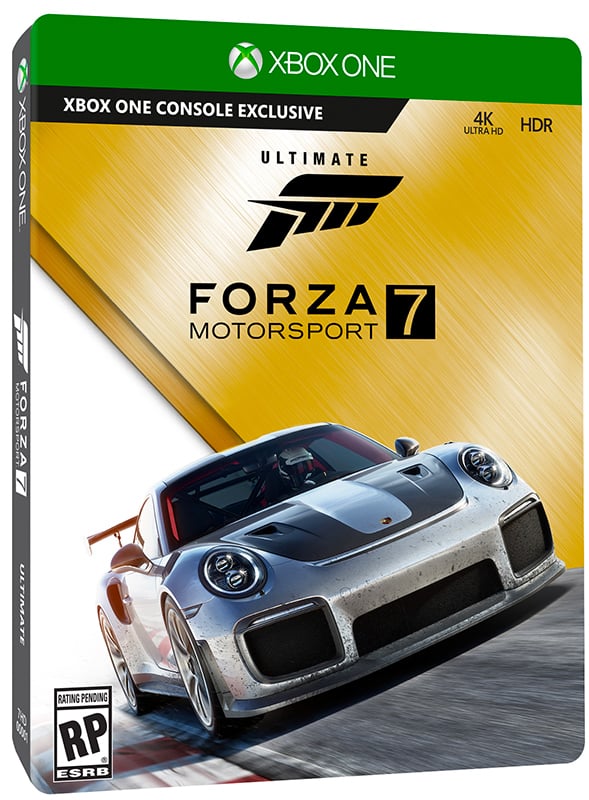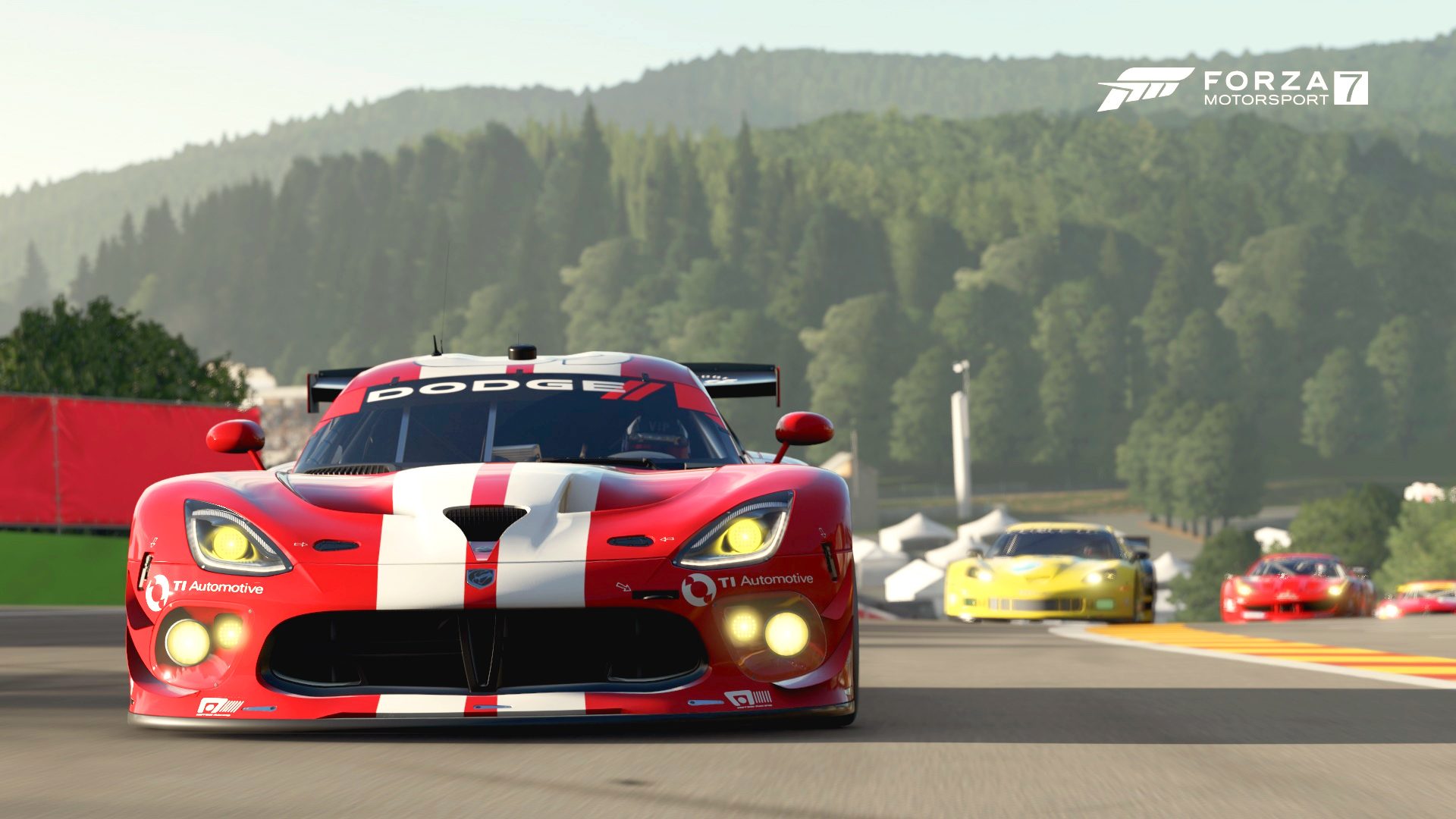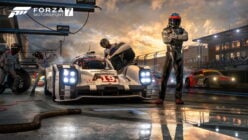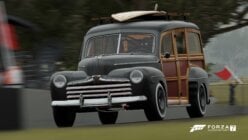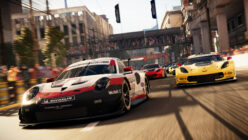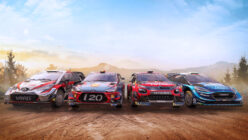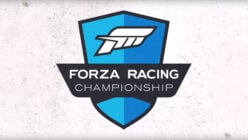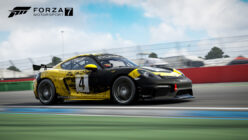“Burn it to the ground.” That was the message from a certain other franchise at E3 this past summer. Proselytizing competition over car collecting, it was a strong statement of intent from a series that had single-handedly created the CARPG sub-genre.
It’s almost impossible to discuss the Forza franchise without also mentioning Gran Turismo. As the stated target for Microsoft’s exclusive since inception, GT’s influence is undeniable. Nonetheless, Turn 10 has found its niche over the last 12 years, giving Forza its own flavor.
Forza Motorsport 7 is the latest in the lineage. It builds on the solid foundations of 2015’s FM6, and rides in on the critical acclaim of last year’s Horizon 3, which holds the distinction of the highest-rated licensed car racing game this generation. This year’s title is also the first full Motorsport game available to PC players.
With its competition focusing on, er, competition, FM7 now has the car encyclopedia part of the genre to itself. Thankfully, the game doesn’t squander the opportunity. FM7 is a huge sandbox of a racing game, offering players the chance to live out their Leno-esque fantasies of owning (and driving) the ultimate car collection.
Microsoft sent us a pre-release review code for Forza Motorsport 7 Ultimate Edition. We conducted this review on a standard Xbox One, using the regular controller as well as the Fanatec CSL Elite for PS4 (with an XB1-compatible wheel).
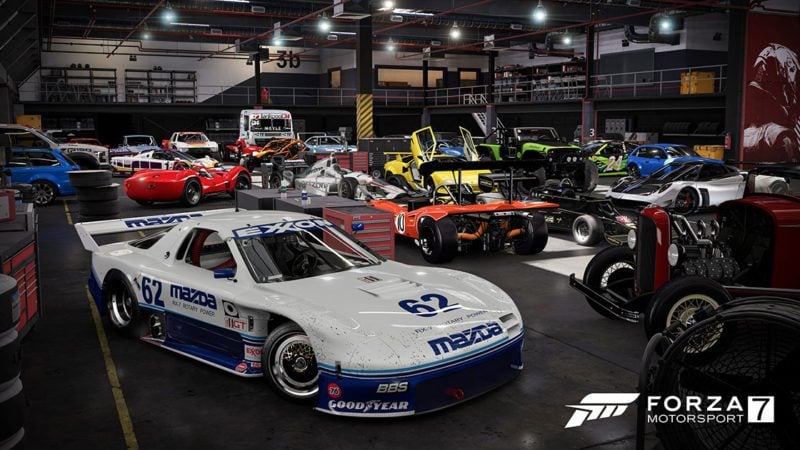
Content and Value For Money –
In case you’re not familiar with the headline figures, here’s a quick refresher. Forza 7 features over 700 cars, and 32 tracks (with over 120 variations). It also includes — for the first time in the Motorsport franchise — dynamic time and weather (on select tracks). The expanded customization options from Horizon 3 are also here, with even more bodykits and aftermarket wheels added to the mix.
There’s a ton of high-quality content here, which explains the game’s enormous download size. Fun fact: that oft-quoted 95GB figure isn’t accurate for the XB1: while the game originally required that much free space, the download was only 67GB. You’ll probably want to find something to do while it downloads.
What’s immediately apparent upon first loading up FM7 is the presentation. The previous Motorsport title was a little too cold and calculating in its menus: it followed a strict grid, laid over the eye-candy that was your car of choice. Selecting a car involved scrolling through still image thumbnails. It was very efficient, but not terribly exciting.
FM7 perks the experience up. Turn 10 has kept the basic grid-style menu approach, but (rightfully) minimized the amount of real estate it takes up on screen. The stars of the show are now your in-game avatar (more on those later) and the cars themselves — as it should be.
When you’re off in the dealership, the cars take pride of place on a large rotating plinth. Selecting the Forza Driver’s Cup swings the camera over to a different section of the main garage. With FM7’s dynamic rock soundtrack playing in the background, it all combines to give a genuine sense of atmosphere — like you’re actually hanging out in a garage.
The problem that’s always faced games with massive car counts is getting players to actually use them. In previous Forzas, there hasn’t really been much incentive to buy cars outside of your preferred models, unless it was needed for an event. The Collection Tier system remedies this.
Basically, the game’s entire car lineup is divided into five categories (Common, Uncommon, Rare, Super Rare, Legendary). In the beginning, you’ll only have access to the first, but as you acquire more cars, through either purchasing or winning them, your Collector Score will go up.
Initially, I was concerned. The idea of locking cars away from players seemed like a step backwards. But the tier system is very generous: Ultimate Edition owners will practically start on the second tier thanks to the Fast & Furious and Hoonigan car packs. But even those with the vanilla version should find it easy to graduate from one tier to the next. I was up to the second-last tier by the end of my first two days with the game, for instance.
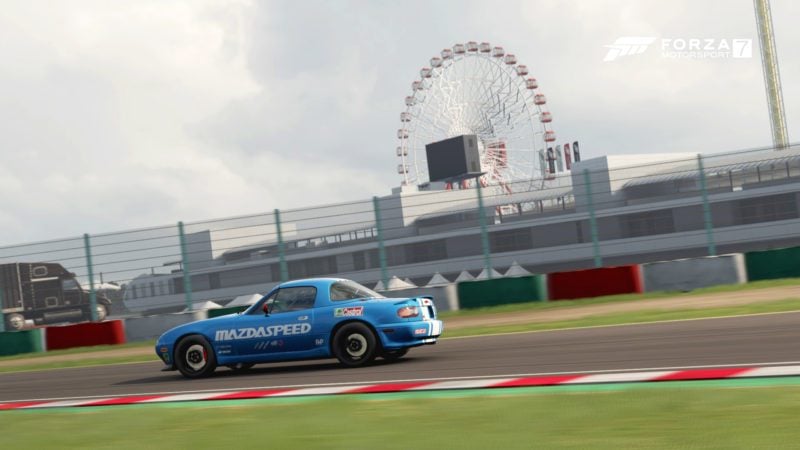
The Forza Driver’s Cup is the basis for the offline career in FM7. It’s a much different approach to what’s come before, and largely, I’d say it’s succeeded. Starting in the first of six cups, players are given a selection of series and one-off Showcase Events to complete. Every option provides you with points; hit the goal however you see fit, and you move on to the next cup. It’s a solid balance between linearity and freedom.
New this installment is the ability to change race length. Finally! No longer are you forced into quick, three-lap races where you need to barge your way through in hopes of making the podium. Now, players can choose from one of a few length presets, and receive a longer, more enjoyable race experience. Credits and XP won post-race scale up accordingly.
The FDC series tend to revolve around Homologation specs. Homologation is Turn 10’s answer to the game’s increasingly diverse car list: it’s a balancing system. Each class has limits for tire compound and width, max power, and PI level.
My little first-gen Miata fits in “Sport Compact Icons”, for example. Here, the cars must have Street tires no wider than 255mm, a max output of 275hp, and a C500 rating.
What homologation does is ensure closer competition, both online and off. Largely, it works: there will undoubtedly still be “leaderboard cars”, but they’ll be slightly better than others in their class, not odd builds that fall through the PI cracks.
The implementation of the system is both good and bad. On one hand, if you purchase a car from the “Car Collection” screen, the game will automatically install parts to get it competitive in-class — at no extra charge. Cool, thanks Turn 10!
The bad news is just that: the game is building the car for you. You can still manually homologate a car, but you’ll be paying out-of-pocket for it. The current system massively favors the pre-existing builds, and while that undoubtedly makes it more approachable for newcomers, it does seem to punish players that want to, in the words of Supertramp, go their own way.
Back to the Driver’s Cup. In every group, there’s one Open event, where you can race whatever car you want, and the AI will match up accordingly. The other races will have you exploring different cars, but if you do the Showcase Events first (and you should), chances are you’ll have the right tool for the job. Showcases gift you the car you use in them, so they’re a solid way to progress not just the career, but also that Collector Score.
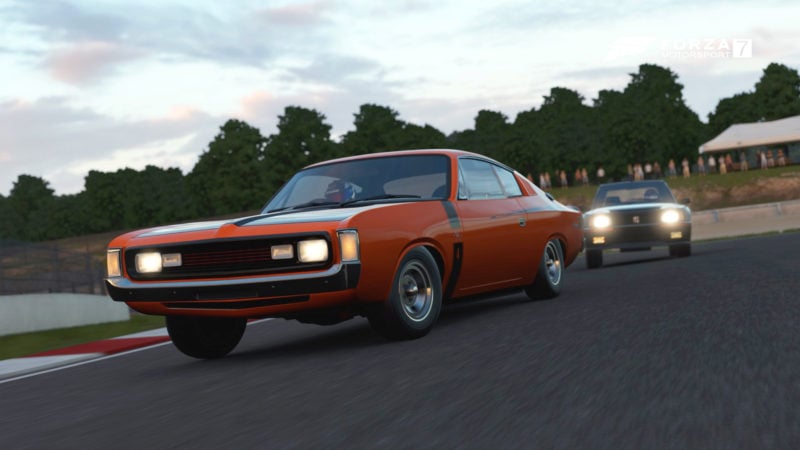
Online Features –
Forza has always had a strong suite of community features. FM7 continues the trend, with the Auction House finally returning to the track-based franchise after appearing in Horizon 3 last year. Combine that with the ability to earn credits off your tunes and paints, and the more creatively-inclined can earn serious coin in-game.
In the run-up to release, the Auction House, Leagues, and Forzathon were all still locked. According to Turn 10, all three will be available shortly, now that the game is on store shelves.
In terms of getting right to racing, FM7 allows players to jump in with minimal fuss. At launch however, the number of hoppers is quite low. There are six presets, five of which use the new Homologation feature. That means that while it’s easy to get on track, it’s not likely you’ll be doing it in your favorite car. Hopefully this is expanded (with the traditional PI classes as well as Homologation settings) in the near future.
Private lobbies can still be set up, of course. Leaderboards also return, though they too are seemingly tied to Homologation classes.
Out on the track, I found the connections rock-solid. There was little to no lag, no matter how many players joined or quit during an event. Due to the nature of the game’s interactive loading screens, there is a little lag there as you first join a room. It has no real affect on the gameplay since you’re just waiting for the track to load, but you will notice your avatar’s jerky movements.
New to the online experience is a way to rate your fellow drivers. Driver feedback is divided into three options: report cheating, report dirty driving, and commend clean racing. It’s a simpler approach to the competitive racing licenses of both Project CARS 2 and GT Sport — we’ll see how it plays out over the coming months, especially once Turn 10 starts ForzaRC back up.
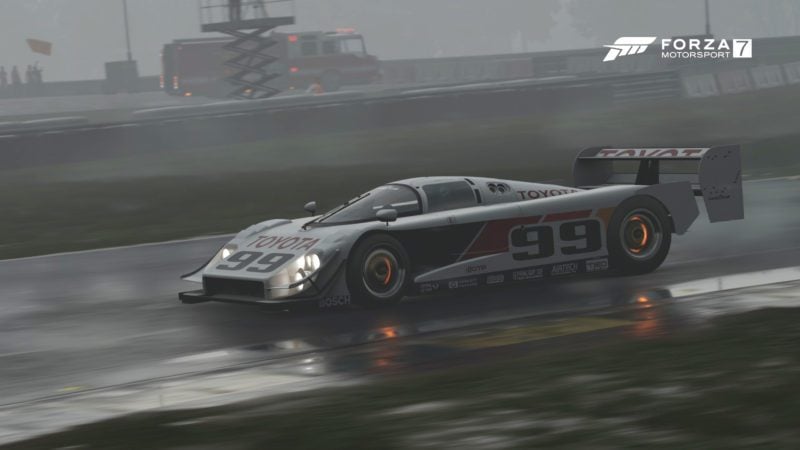
Driving Physics & Handling –
Let’s be clear: Forza is far from the final word on physics. It’s not even in the same chapter as the final word, because that sounds a bit too much like reading, and reading sounds like work — something FM7 doesn’t much care for. It’s too busy having fun.
Cars feel realistic enough; they react as you’d expect based on their stats. There just isn’t the nuance you’ll find in titles like Assetto Corsa or Project CARS 2. In broad strokes, the cars feel good: older muscle cars have a softer edge to their handling envelope, with soft suspension and equally soft sidewalls. Race cars have bags of grip — both mechanical and aerodynamic — but running them at ten-tenths means balancing on a knife’s edge.
FM6 felt, at times, almost pre-disposed to oversteer antics. It seems like Turn 10 took this criticism on board, but has almost gone too far the other way. Understeer is a constant threat in Forza 7, requiring pretty judicious stomps on the pedals to really get the cars out of shape. Yes, modern road cars tend to push at their limits, but when a classic 930 Turbo isn’t trying to kill me, some part of me is disappointed.
The vintage F1 cars are some of the most fun you can have. The ’60s era cars are all about finding that balance of juuuust sliding the rear enough to start putting the power down the moment you hit the apex. Jump forward a decade, and it’s all about downforce. In a way, the ’70s cars are easier to drive, but they’re no less thrilling when you nail that perfect lap.
As always, Forza has excellent controller implementation. The XB1 pad really communicates what the car is doing, both through its general FFB and those excellent rumbly triggers. Road Atlanta’s first section requires you to use every inch of the rumble strips to maximize corner speeds. Here, the controller faithfully tells you when you’ve hooked onto one.
We first heard about Forza 7 late last year via Fanatec. Company CEO Thomas Jackermeier had promising news, that a “wheel guy” was now responsible for physics and force feedback. The good news first: the wheel implementation is indeed better than it was in FM6.
After a bit of tweaking, the CSL Elite actually felt quite good. At the time of writing, it still feels a little vague around the center, but past that, it has a strong, consistent feel the rest of its travel. Force feedback from curbs and trading paint is excellent.
The main issue with the wheel is a lack of surface detail. In fact, it’s almost the opposite of the experience I had fine-tuning the Elite with our Project CARS 2 review last month. The Nürburgring is about the only place the wheel really translates what the wheels are dealing with on the racing surface.
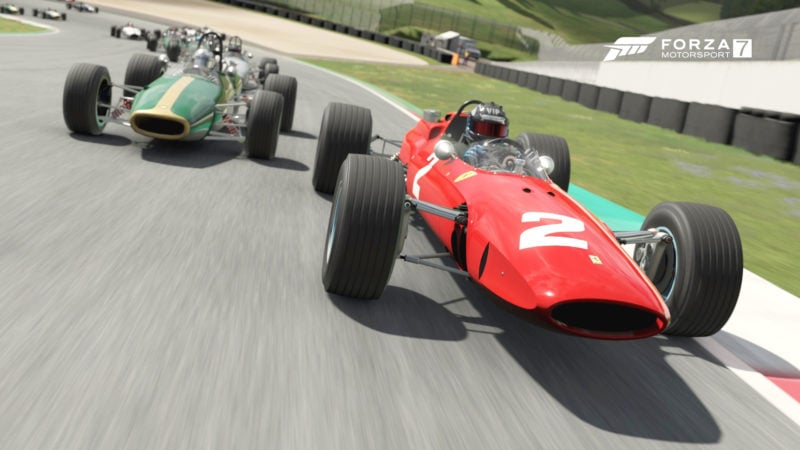
Driver assists are a mixed bag in FM7. They’re all the same as before, with one new, controversial addition: friction assist. For those familiar with GT6, think of this new one as Skid Recovery Force — on steroids. Friction assist removes any of the slowdown a car experiences off-track.
It’s ostensibly for very young players and/or complete racing game noobs, but its inclusion nonetheless feels dirty. Assists should teach players more about the existing physics engine — not ignore certain parts of it for convenience. Luckily, this assist will dirty any and all lap times it’s used with, so leaderboards are safe. In terms of online racing, only the beginner room will allow it.
Taking the glass half-empty approach, it’s easy to conclude that Turn 10’s choice to remove credit bonuses for using less assists is a way to push players towards the dubious loot crate/mod system. With a more optimistic mindset, I’d like to think it’s a gradual move towards what games like Project CARS 2 and Assetto Corsa do: realistic driver aid settings.
Modern day cars are getting more and more complicated. As much as some sim racers love to tout their “pure” approach sans aids, the truth is most of these aids, in the real world, would actually make them faster.
Speaking of complications, Forza 7 over-simplifies the hybrid prototypes. I’m not asking for the sort of experience that requires a tech manual — looking at you, Ferrari F1 cars in Assetto Corsa — but there’s a lot of happy middle ground between the two extremes. With a clear lead over the rest of the genre in terms of car roster, I hope Turn 10 starts giving more attention to the individual driving experience of each one of these cars.
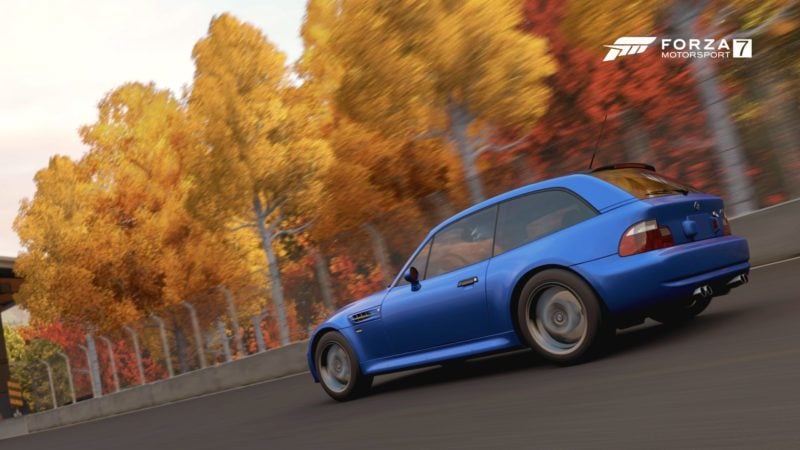
Graphics –
When Microsoft first showed Forza 7 to gamers at E3 in June, it did so on the pumped-up One X. It was understandable: why wouldn’t the company use one of its headline exclusives to showcase the new uber-system? As summer flew by, Turn 10 revealed more and more of the game, but never on the base ‘box. Some people began to worry.
It turns out they shouldn’t have. Yes, FM7 does look worse on the 2013-spec machine compared to the new liquid-cooled unit, but it’s certainly not ugly. It can’t match the visual splendor of GT Sport, but Forza 7 does still manage a rock-solid 1080p60 picture. On consoles, that’s something neither of its main competitors hit — well, Polyphony’s title just may when it arrives later this month.
Swapping between FM6 and FM7, car models look more natural in their environments. Forzavista returns, offering players the chance to truly get up close with the stars of the show. This time around, you can even enter the mode on pit lane instead of just the main home space. Peaking under the hood of a classic supercar in the rain just feels more real — luckily, without the whole getting wet part.
Out on the track, the wipers, mirrors, and safety webbing all shake at speed. It’s not new (other games have been doing it for years), but it nonetheless adds a little more to the immersion.
Where FM7 shines most is actually when the sun isn’t visible. Simply put, rainy weather looks fantastic. Tracks take on a gloomy blue hue, with thunder and lightning to really sell it. The puddles have (thankfully) shrunk since FM6. No longer will you see a small lake forming at Brands Hatch.
The weather and time changes utilize the same semi-dynamic settings from Forza Horizon 3. What do I mean by semi-dynamic? From my time with the game, it seems time-of-day transitions are more or less “baked in”. A race at Yas Marina at night will always have the same cloud coverage, for example.
Rain is a bit different. Turn 10 has included a novel probability system, where players can choose the likelihood of the mid and end-race scenarios. There are sixteen inclement weather options, ranging from partly cloudy, through levels of fog, right to heavy rain.
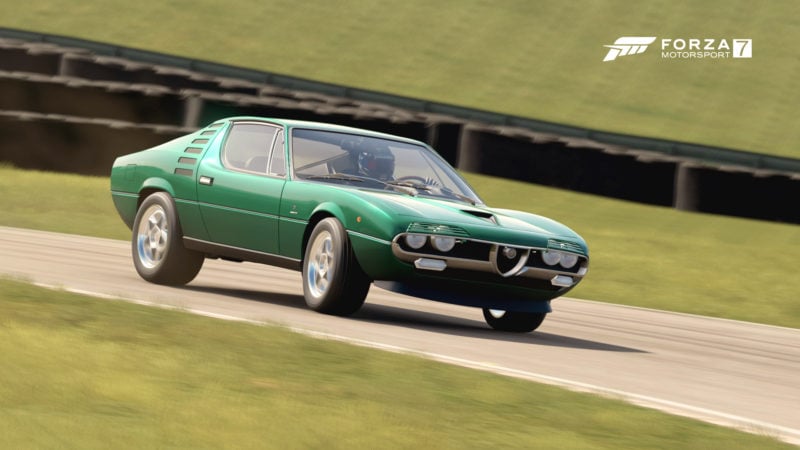
Sound Design –
There’s been a lot of little tweaks to the sound engine this go-round. The spatial aspect is key here: you can hear cars battling off in the distance, with their war cries building up as they draw closer. Mount a rumble strip a little too enthusiastically, and you’ll hear the suspension protest.
As expected, the weather really helps show off the improvements too, be it the sound of thunder rolling in or the wipers working to keep your view of the track clear.
With 700 cars in the game, there’s lots of audio goodness to take in. Not all of them are hits — the Caddy limo still sounds far too mean for something meant to transport teenagers to prom. But largely, the cars that I sampled sounded as they should.
The backing score stays throughout the game. Like earlier Forza Motorsport titles, it’s dynamic, changing as you play. What’s different is that it’s straight-forward rock now. With both of the game’s competitors staking out jazz and classical, it imbues FM7 with a different feel. You may not like it, but this writer was on board. I would’ve liked it even more if the custom music feature was in-game; we’re told it’s coming in a future update. The cancellation of Microsoft’s Groove Music is probably why.
Popping into events within the career, you’ll occasionally be treated to a voiceover by one of sixteen automotive personalities. Heading into a showcase event, series veteran Tanner Foust will give you advice on how to tackle a one-on-one race. Another time, Rutledge Wood expounds the virtues of the American muscle car.
It’s a nice peek at the culture behind the automobile. One brief snippet stood out to me the most: it was FCA’s Head of Design Ralph Gilles, talking about the 911, and the huge impact it had on him as a child. It was refreshingly off-the-cuff, shorn of politics and PR. We rarely hear company higher-ups talking about competitors’ cars in such glowing ways. It’s a reminder that, above all else, the main thing we have in common is that we all just love cars.
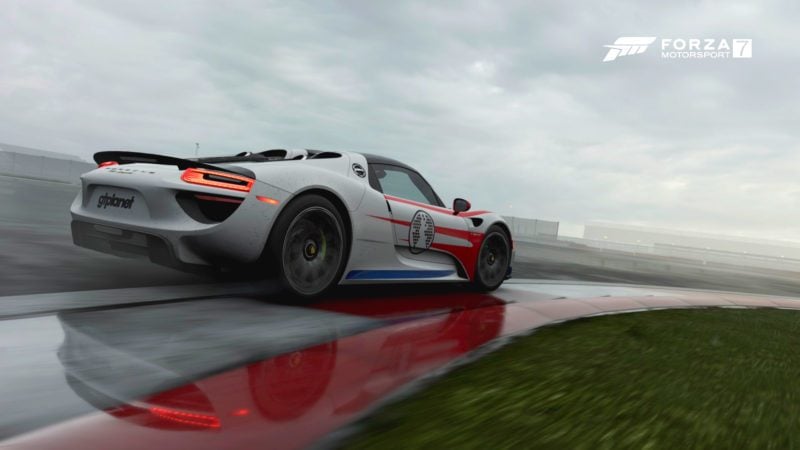
The Verdict
Forza Motorsport 7 feels decidedly old-school. This is the classic CARPG-style game many of us remember fondly from last decade. It’s realistic enough for most people, and has so much content that it’d take you years to explore all of it.
Turn 10’s mission statement has long been about turning gamers into automotive enthusiasts, as well as the other way around. With that in mind, FM7 seems tailor-made for the goal. It balances the more sim-style features with plenty of gamey ones.
Chief amongst those gamey features is the career, and it’s a breath of fresh air. For too long we’ve put up with lousy, half-baked offline modes in the never-ending chase for “realism” in the racing genre. But these are video games, and a good, engaging offline experience should not be mutually exclusive to a solid on-track one. Same too with online versus offline: the former can be a ton of fun, but it also means putting your potential enjoyment in the hands of others. A good game does both.
There are concerns for the future though, like the news of microtransactions. I’ve played the game for nearly a week and have avoided the prize crates while racking up over 100 cars. The economy is much better-balanced than FM6, which always threw money at you. But depending on how MTs are implemented with regards to loot crates — and how much content is locked behind that gambling mechanic — Turn 10 could be throwing away all the goodwill it has earned this generation.
In its current form, Forza 7 does a lot of things for a lot of people. It’s the Forza Greatest Hits album. Given the series’ big changes, it’s also more like the Gran Turismos of old than GT Sport. If you’re looking for a game in the car-encyclopedia mold, an automotive jack-of-all-trades, you’d be hard-pressed to find a more suitable candidate.
EDITOR’S NOTE: The consumable VIP situation has taken another turn As of October 5, Turn 10 has begun sending gift cars and credits to all existing VIP members. Also, the team will be converting the VIP system to the permanent 2x approach a la FM6. You can read the full details here.
Forza Motorsport 7 (XB1)
Learn more about how our rating system works.
